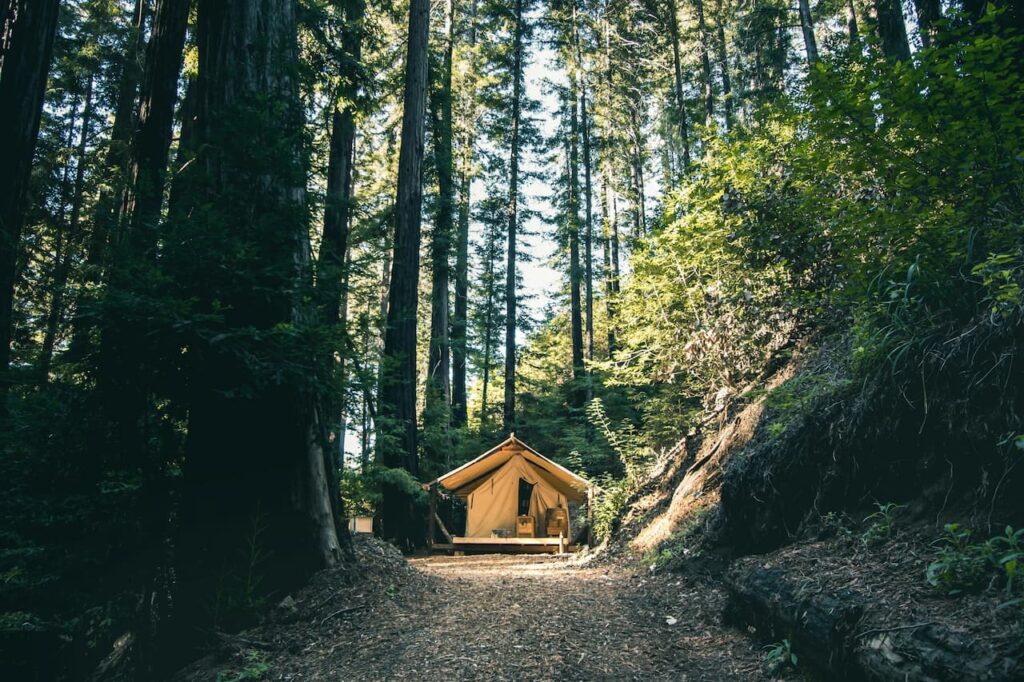Eco-luxury travel is catching on because more and more people are seeing that luxury doesn’t have to be at odds with being eco-friendly.
Historic Hotels In The US
Let’s look at those well-established hotels across the US.
They’re known for their luxury and historical significance, aren’t they?
But now they’re getting noticed for something else too – their push towards sustainability.
These places are finding smart ways to save water and choose eco-friendly materials, all while keeping the luxury.
Glamping Is Where Nature Meets Luxury
Glamping stands for glamorous camping.
You are surrounded by nature without compromising on comfort.
It teaches us how to enjoy luxury mindfully.
Key Practices in Eco-Luxury
Digging into what makes these historic hotels and glamping sites both luxurious and green, here are some key practices:
- Historic hotels are making big moves in energy efficiency (like switching to LED lights and upgrading to more efficient HVAC systems), water conservation (think low-flow showers and faucets), and choosing sustainable materials.
- Glamping focuses on creating living spaces that blend in with the nature, such as tents or yurts. They’re big on renewable energy, often using solar panels and produce their own limited power. Plus, they support local and organic food initiatives.
A Shared Dedication to Nature
The glue holding these experiences together is the respect for nature.
It’s about indulging in luxury that doesn’t cost the earth, literally speaking.
Examples of Sustainability in Action
The Fairmont San Francisco
Take the Fairmont San Francisco as an example. This iconic hotel is a front-runner in sustainable luxury, shining with LED lighting and operating on high-efficiency boilers to cut down on energy use. Their water conservation efforts, like installing low-flow fixtures, massively reduce waste. And when it comes to renovations, they opt for materials that are both posh and planet-friendly, such as bamboo flooring or recycled tiles.
They’re working on cutting down their carbon footprint to zero by 2050 and getting rid of single-use plastics in their hotels. They’re big on saving energy, using water wisely, and reducing waste. Plus, when they fix up or build new parts of their hotels, they go for green options like bamboo floors or recycled materials. This is all part of a bigger plan by their parent company, Accor, to be more sustainable across all their hotels globally. So, it’s not just talk; they’re taking real steps to be better for the planet.

Glamping in Big Sur
Big Sur glamping offers sites designed to meld with the landscape, featuring structures like tents and yurts that barely leave a footprint.
They harness the power of the sun with solar panels, and when it comes to food, they’re all about local and organic, championing the local agriculture while cutting down on emissions.
Actionable Tips for Travelers
- Be mindful of your water usage. Simple actions like taking shorter showers, reusing towels, and turning off the tap while brushing your teeth can make a significant difference in water conservation.
- Reduce your plastic footprint. Pack reusable items like water bottles, shopping bags, and straws.
- Whenever possible choose public transport, cycling, or walking over renting a car. If a car is necessary, opt for electric or hybrid vehicles.
- Engage with wildlife ethically. Choose tours and activities that respect animal welfare and support conservation efforts such whale watching tours in Monterey where tour operators have marine biologist on boat doing research and they also collect plastic from the ocean on their way back. Hikinginbigsur.com has a collection of best whale watching tours in Monterey that you can check out.
- Look for accommodations that have recognized environmental certifications such as LEED (Leadership in Energy and Environmental Design), Green Key, or EarthCheck.
The Future of Travel
In a world where the impact of tourism is increasingly under the microscope, eco-luxury travel offers a blueprint for the future — one where travel not only takes us to incredible places but also helps keep them that way for generations to come.